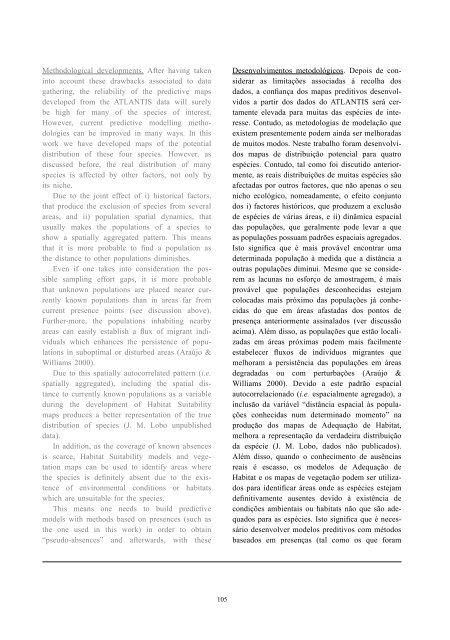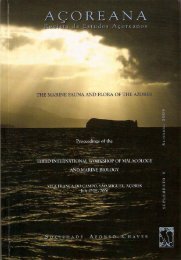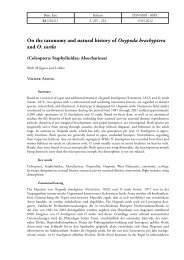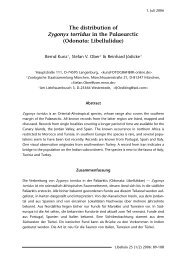(eds.) (2005). - Portal da Biodiversidade dos Açores - Universidade ...
(eds.) (2005). - Portal da Biodiversidade dos Açores - Universidade ...
(eds.) (2005). - Portal da Biodiversidade dos Açores - Universidade ...
You also want an ePaper? Increase the reach of your titles
YUMPU automatically turns print PDFs into web optimized ePapers that Google loves.
Methodological developments. After having taken<br />
into account these drawbacks associated to <strong>da</strong>ta<br />
gathering, the reliability of the predictive maps<br />
developed from the ATLANTIS <strong>da</strong>ta will surely<br />
be high for many of the species of interest.<br />
However, current predictive modelling methodologies<br />
can be improved in many ways. In this<br />
work we have developed maps of the potential<br />
distribution of these four species. However, as<br />
discussed before, the real distribution of many<br />
species is affected by other factors, not only by<br />
its niche.<br />
Due to the joint effect of i) historical factors,<br />
that produce the exclusion of species from several<br />
areas, and ii) population spatial dynamics, that<br />
usually makes the populations of a species to<br />
show a spatially aggregated pattern. This means<br />
that it is more probable to find a population as<br />
the distance to other populations diminishes.<br />
Even if one takes into consideration the possible<br />
sampling effort gaps, it is more probable<br />
that unknown populations are placed nearer currently<br />
known populations than in areas far from<br />
current presence points (see discussion above).<br />
Further-more, the populations inhabiting nearby<br />
areas can easily establish a flux of migrant individuals<br />
which enhances the persistence of populations<br />
in suboptimal or disturbed areas (Araújo &<br />
Williams 2000).<br />
Due to this spatially autocorrelated pattern (i.e.<br />
spatially aggregated), including the spatial distance<br />
to currently known populations as a variable<br />
during the development of Habitat Suitability<br />
maps produces a better representation of the true<br />
distribution of species (J. M. Lobo unpublished<br />
<strong>da</strong>ta).<br />
In addition, as the coverage of known absences<br />
is scarce, Habitat Suitability models and vegetation<br />
maps can be used to identify areas where<br />
the species is definitely absent due to the existence<br />
of environmental conditions or habitats<br />
which are unsuitable for the species.<br />
This means one ne<strong>eds</strong> to build predictive<br />
models with methods based on presences (such as<br />
the one used in this work) in order to obtain<br />
“pseudo-absences” and afterwards, with these<br />
105<br />
Desenvolvimentos metodológicos. Depois de considerar<br />
as limitações associa<strong>da</strong>s à recolha <strong>dos</strong><br />
<strong>da</strong><strong>dos</strong>, a confiança <strong>dos</strong> mapas preditivos desenvolvi<strong>dos</strong><br />
a partir <strong>dos</strong> <strong>da</strong><strong>dos</strong> do ATLANTIS será certamente<br />
eleva<strong>da</strong> para muitas <strong>da</strong>s espécies de interesse.<br />
Contudo, as metodologias de modelação que<br />
existem presentemente podem ain<strong>da</strong> ser melhora<strong>da</strong>s<br />
de muitos mo<strong>dos</strong>. Neste trabalho foram desenvolvi<strong>dos</strong><br />
mapas de distribuição potencial para quatro<br />
espécies. Contudo, tal como foi discutido anteriormente,<br />
as reais distribuições de muitas espécies são<br />
afecta<strong>da</strong>s por outros factores, que não apenas o seu<br />
nicho ecológico, nomea<strong>da</strong>mente, o efeito conjunto<br />
<strong>dos</strong> i) factores históricos, que produzem a exclusão<br />
de espécies de várias áreas, e ii) dinâmica espacial<br />
<strong>da</strong>s populações, que geralmente pode levar a que<br />
as populações possuam padrões espaciais agrega<strong>dos</strong>.<br />
Isto significa que é mais provável encontrar uma<br />
determina<strong>da</strong> população à medi<strong>da</strong> que a distância a<br />
outras populações diminui. Mesmo que se considerem<br />
as lacunas no esforço de amostragem, é mais<br />
provável que populações desconheci<strong>da</strong>s estejam<br />
coloca<strong>da</strong>s mais próximo <strong>da</strong>s populações já conheci<strong>da</strong>s<br />
do que em áreas afasta<strong>da</strong>s <strong>dos</strong> pontos de<br />
presença anteriormente assinala<strong>dos</strong> (ver discussão<br />
acima). Além disso, as populações que estão localiza<strong>da</strong>s<br />
em áreas próximas podem mais facilmente<br />
estabelecer fluxos de indivíduos migrantes que<br />
melhoram a persistência <strong>da</strong>s populações em áreas<br />
degra<strong>da</strong><strong>da</strong>s ou com perturbações (Araújo &<br />
Williams 2000). Devido a este padrão espacial<br />
autocorrelacionado (i.e. espacialmente agregado), a<br />
inclusão <strong>da</strong> variável “distância espacial às populações<br />
conheci<strong>da</strong>s num determinado momento” na<br />
produção <strong>dos</strong> mapas de Adequação de Habitat,<br />
melhora a representação <strong>da</strong> ver<strong>da</strong>deira distribuição<br />
<strong>da</strong> espécie (J. M. Lobo, <strong>da</strong><strong>dos</strong> não publica<strong>dos</strong>).<br />
Além disso, quando o conhecimento de ausências<br />
reais é escasso, os modelos de Adequação de<br />
Habitat e os mapas de vegetação podem ser utiliza<strong>dos</strong><br />
para identificar áreas onde as espécies estejam<br />
definitivamente ausentes devido à existência de<br />
condições ambientais ou habitats não que são adequa<strong>dos</strong><br />
para as espécies. Isto significa que é necessário<br />
desenvolver modelos preditivos com méto<strong>dos</strong><br />
basea<strong>dos</strong> em presenças (tal como os que foram

















